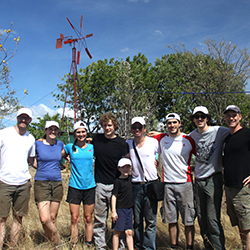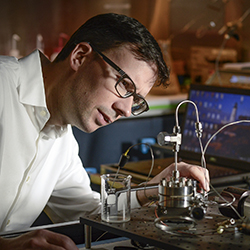March 30, 2016 — Today the University of Toronto unveiled its plan for taking action on climate change in a bold report, Beyond Divestment: Taking Decisive Action on Climate Change.
“The University’s most valuable and effective contributions to the global effort to avert and mitigate the consequences of climate change will flow from our fundamental role as an institution of research and education,” said University of Toronto President Meric Gertler.
Read more about the 14-point plan.
These five projects are just a few underway in U of T Engineering that are helping make the world greener, from the fields of Nicaragua to the nearest airport.
 Building windmills in Nicaragua
Building windmills in Nicaragua
A group led by Mechanical & Industrial Engineering Professor Amy Bilton is partnering with residents of Pedro Arauz, Nicaragua to design and construct a water-pumping windmill, providing critical irrigation during the area’s long dry season.
The project was launched as part of a fourth-year course in the Department of Mechanical & Industrial Engineering. Over the last two years, three different teams of undergraduate students have worked closely with members of the local community as well as the Winds of Change initiative to make the windmill a reality.
The area has plenty of groundwater and dug wells, but hand pumps — currently the most widespread pump technology — are simply not powerful enough to produce the thousands of gallons of water required for crop irrigation. The use of diesel and electrical pumps is limited by a lack of infrastructure, high cost and difficulties with the importing of goods. By contrast, wind pumps can be built and maintained using locally available materials, and the climate in Nicaragua is windy enough to provide the required energy.
“From the beginning, it was engineering students working together with community members who provided great suggestions in terms the local practices and available resources,” said Bilton. “Everyone was so kind and so welcoming. I think that was really what moved the students and helped motivate them as they worked on the project.”
 Growing ‘pond scum’ for fuel
Growing ‘pond scum’ for fuel
Need green energy? Someday you may need to look no further than the green scum coating the nearest puddle.
Mechanical & Industrial Engineering Professor David Sinton’s research focuses on optimizing the growth of algae and cyanobacteria — often considered ‘pond scum’. Algae and cyanobacteria are photosynthetic microorganisms that can use solar energy to convert carbon dioxide (CO2) into chemical products and ultimately fuels. Among the fastest-growing photosynthetic organisms on earth, some species accumulate high levels of fat and oil that could be refined into biofuels, or sugars that could be fermented into ethanol.
Despite decades of research, there is still much uncertainty about the exact conditions that each species needs to grow at its optimal rate, or accumulate the most product. The number of variables — light intensity, light spectrum, nutrient and CO2 levels, temperature and more — makes designing experiments to cover all possible combinations both difficult and costly.
Sinton and his team are addressing that problem using their expertise in microfluidics and optofluidics, two fields that look at how fluids and light can be conducted through very small channels or optical conductors. They recently designed a “lab on a chip” that contains hundreds of individual chambers in which the microorganisms can grow.